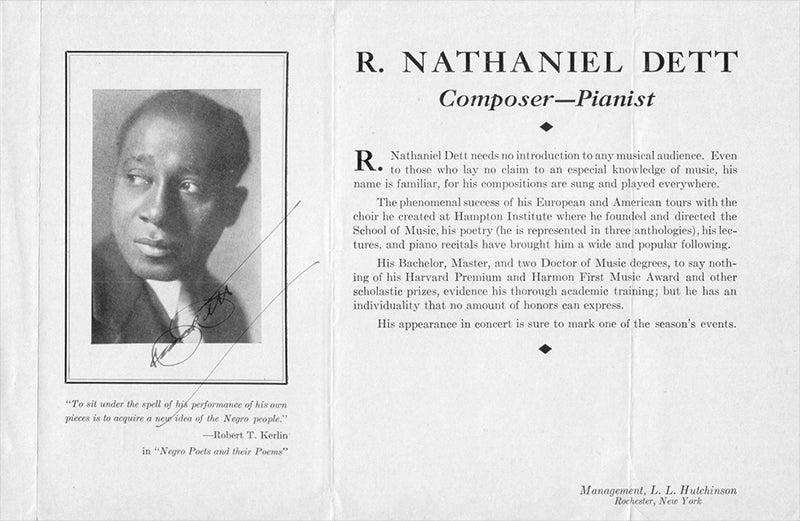
R. Nathaniel Dent (1882-1943). Promotional handbill (ca. 1935). From the James Murphy Collection.
Items in the Exhibition:
Music in the Mine: An Unaccompanied Folk-song Scena for Tenor Solo and Mixed Chorus
New York: G. Schirmer [© 1916] Inscribed on December 26, 1916, by the composer "To my dear friend Miss Natalie Curtis one of the very first to see in this simple tune the possibilities of [illegible] treatment and development. "
The Chariot Jubilee: Motet For Tenor Solo and Chorus of Mixed Voices accompaniment of Organ (piano) or Orchestra
Cincinnati: John Church [© 1919]
Inscribed on August 12, 1919, by the composer "To my friends Mr. and Mrs. Paul Burlin Yea "the birds chirping did herald the dawn." Dare I say the sun begins to rise? But though the day be not fair, I know it will be welcomed by you who have worked so hard that such things might be."
Listen to the Lambs: A Religious Characteristic in the form of an Anthem For Four-part Chorus of Mixed Voices
New York: G. Schirmer [© 1914]
Another copy of the same; inscribed by the composer on December 26 of the following year "To my dear friend and inspirer Miss Natalie Curtis in artistic appreciation of her noble endeavors for the music of the unappreciated races. Sincerely and gratefully . . . ."
I’m So Glad Trouble Don’t Last Alway: Negro Spiritual For Three Part Chorus of Women’s Voices with Accompaniment.
Cincinnati: John Church [© 1919]
Done Paid My Vow To The Lord: Negro Spiritual For Baritone or Contralto Solo and Chorus of Women’s Voices with Accompaniment.
(A song much beloved by Booker T. Washington)
Cincinnati: John Church [© 1919]
Nobody Knows the Trouble I See: American Negro Melody
John Rosamond, 1873-1954
Boston: Oliver Ditson [© 1917]
Inscribed in July 1917 by the composer "To Mrs. Natalie Curtis-Burlin Compliments of...."
Natalie Curtis Burlin (1875-1921)
Natalie Curtis aborted a possible career as a concert pianist to study Native American music and languages, her major publication being The Indians’ Book (1907). After 1910 she took an active interest in developing music and music education for African Americans. In 1917 she married artist Paul Burlin. She was killed by an automobile in Paris while there to give a lecture in 1921. All the works shown were presented to her by the composers.
This exhibition was curated by George M. Barringer, Associate University Librarian for Special Collections, February 2005.
